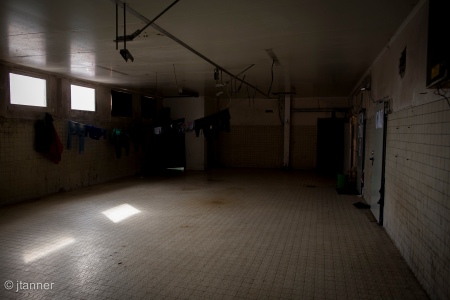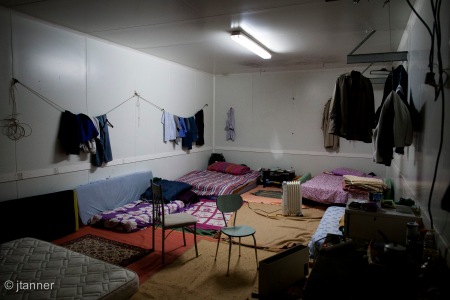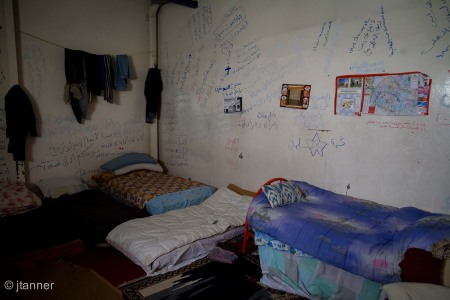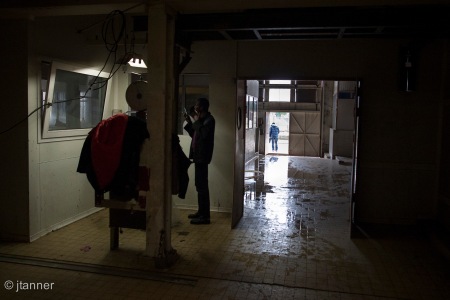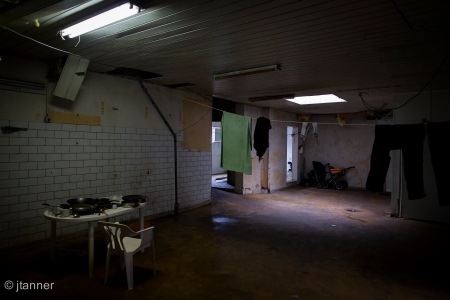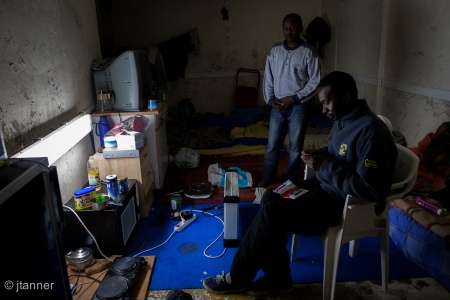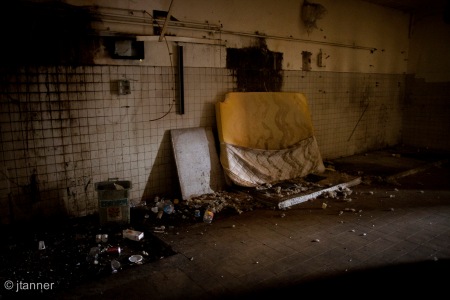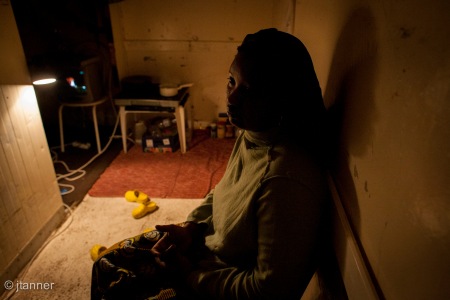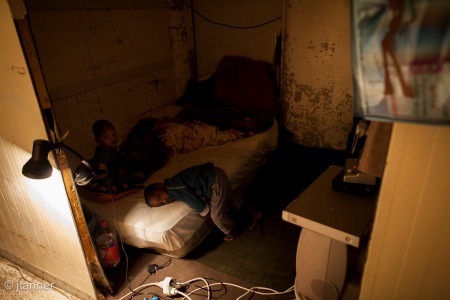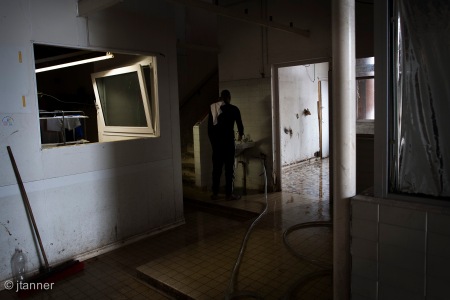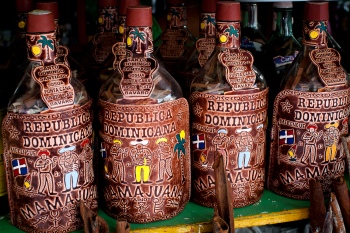Hotel Refuges
August 6, 2013
On the outskirts of French city Dijon is Bertillon. A building being used as a squat hosting some 100 asylum-seekers, mostly from Mali, Somalia, Chad, but also around 20 people originating from Eastern Europe, Georgia, Kosovo.
For the past several years, France has been one of the top two countries in Europe that receives the most asylum claims annually. There is a housing shortage for asylum seekers in France. Many asylum seekers must go to emergency shelters or hotels or come up with creative lodging. In addition, the asylum procedure is slow and this adds to the housing shortage.
Sometimes asylum seekers are homeless and so left to cope with the lack of housing issue on their own. Even if they apply for asylum, they may not receive housing
The former meat-packing factory has only one toilet and two sources of running water.
Cold storage/freezing rooms are now used as bedrooms and a mosque, with mattresses on the floors providing a sleeping arrangement for desperate asylum seekers.
There is no heating, no cooking, kitchen facilities, no bathing facilities and only sporadic supplies of electricity.
Most of asylum seekers are Men apart from a one family from Eastern Europe and a thirty year old Guinean woman and her three children. Ms. Diallo Oumou Hawa, a 30 year old woman and two of her 3 children originating from Guinea. Ms Hawa escaped Guinea after the death of her husband. His family wanted to force her into an arranged marriage. She arrived in Dijon seeking asylum on 2/12/2012 with her three sons (two twins aged 3 and the older aged 10).
Her journey was facilitated by a people smuggler, in exchange for leaving him the deeds/documents of the houses the husband left her he facilitated false travel documents and flights to France. Arriving by plane to Paris and then by train to Dijon.
She lives anxiously in the squat, surrounded by some 100 asylum seeking men, with no access to clean/safe drinking water, washing facilities or reliable electricity. A local association recently paid for a lock to her door as she fears for her safety and that of her children.
She is very grateful for association in the help they have given her son to attend school.
The disused building is infested with rats and mice and several of the floors flood with leaking pipework.
Dispatch: Running from War!
March 14, 2013
“Mister, Mister, photo, take my photo”
why?
“because this is what I look like, I am refugee!”

This week, the 1 millionth refugee was registered in Jordan. I have visited the Za’atri refugee camp twice in the last 6 months.
When I visited last in December there were 2000-3000 refuges a day fleeing Syria. Last month that figure was up to 8000 people a day. More than half of all those fleeing are children.
I have worked for UNHCR in refugee camps in about a dozen countries in recent years, but never have I seen children so affected by what they’ve seen and experienced in Syria.
Regardless of hardship or circumstance, children always smile, laugh, and perform in front of the camera, even in refugee camps. In this 20-minute or so photo session, not a single child passed a smile.

Waiting in line, unhurried, they stood in close ranks, careful not to stand on anyone else’s toes in the darkened entrance of a family’s tent. These were unlike most kids I had see in other refugee camps around the world.
Patiently and with little fuss, they stepped intuitively into the light; click, click couple of frames then walked dispassionately to the side, to the dark. No acknowledgement, nothing. Next child. Sidestepping into the cameras line of sight, baby steps up to the light overhead. Stare and exit left.
At the end they waited patiently to see the results on the back of the camera,. Before I’d even finished ‘chimping’ through the frames, most began walking away, clearly ambivalent to the experience.
How many photographers must they have seen come through the camp. Do they even care? Is this what they had in mind when they were shouting “mister mister, take my photo?
In time, they will have photos just like these that identify them in a passport. Instead of being forced to leave a country, they will be free to travel across borders at will.
For now, with no end in sight to this conflict, their refugee status is their passport.
More images from this series can be seen HERE


End.
War Surgeon
February 25, 2013
Dr Jorma Salmeda

It was necessity rather than choice that Dr Salmeda became a war surgeon. When he started his medical training in the late 1960s, Finland was still struggling to cope with some 200,000 war wounded personnel from the Second World War. The government’s response was a requirement that all Finnish surgeons undergoing medical training also study the principles and practices of war surgery. Throughout his medical training, Dr Salmeda’s primary interest was always trauma, so it naturally followed that the field of war surgery was particularly inviting.
Dr Salmeda started work with the Finnish Red Cross in 1974. In 1982 he accepted his first overseas assignment, with the ICRC in the frontier town of Peshawar on the Pak-Afghan border. Pakistan could not cope with the influx of weapon-wounded casualties from the conflict in neighbouring Afghanistan. It appealed to the ICRC for assistance in running a specialist surgical unit dealing with those fleeing the war there. At that time, the Russians were not permitting any NGOs to operate from inside Afghanistan, so Peshawar was the closest ICRC could get to dealing with casualties from the war.
The number of wounded civilians coming out of Afghanistan was so high that within three more months they had extended the unit from an initial 40-bed facility to 150 beds. Dr Salmeda remembers there were reports of some 6 million afghan refugees in Pakistan during the early 1980s.
In 1988 the ICRC finally gained permission to open their first delegation in Kabul. On 16th April 1992, infighting between warlords resulted in a brutal civil war in Afghanistan. Dr Salmeda recalls that the resulting fighting did more damage to Kabul than the Russians ever managed. It was during this time that Dr Salmeda says he experienced the worst moment in his medical career. In July 1992, Dr Salmeda was in charge of triage at the ICRC hospital when a rocket attack on a nearby market and bus station resulted in the more than 200 civilians killed, and more than 700 critically injured. The hospital admitted more than 400 patients in the first two hours following the attack.
Each corner of the hospital was filled with injured patients, he says. They filled the corridors, kitchens, storerooms, reception areas, everywhere. It took two days and a night just to get patients through triage. Salmeda was fortunate to have five surgical teams to deal with the injured. He says the experience was a good exercise in dealing with weapon-wounded patients for all the surgeons that day.

It was also during this time he says the Taliban made the first of three attempts on his life. The first was in April 1982. He had been ‘on call’ at the hospital, and had just returned home and was preparing to get some rest. He went to the bathroom when a sniper opened fire on the house, destroying the bedroom where he would have been . The second attempt came later the same day. The sniper attack was a prelude to fierce house-to-house fighting between different tribes seeking control of the city. Sprayed gunfire confined him to lying face down on the floor while gun battles raged throughout the neighbourhood. When he finally got off the floor of his bullet-ridden room and stood up, a mujahid approached and put a rifle to his forehead.
He recalls how he watched the fighter’s finger tighten around the trigger. Just as the militant was about to pull the trigger, Salmeda’s cook entered the room and pleaded to spare his life, explaining he was a doctor. Dr Salmeda says what happened in the coming minutes was a flood of 10 mujahideen coming into the house seeking medical treatment. While some hours earlier they were intent on clearing the house and killing anyone inside, the doctor was now the mujahideen’s new best friend.
The third attempt came when he was assisting a fellow surgeon during an operation at the field hospital. He says a disturbed relative of one of the patients entered the theatre and opened fire. Dr Salmeda says he felt a bullet pass by his hair.

After so much violence, he relocated to the Cambodian-Thai border with the Finnish Red Cross in 1983 for a three-month assignment to assist with treatment of those fleeing the genocide in Cambodia. Two years later, he returned to Peshawar for a three-month posting. He returned again in 1986-87 to Pakistan as medical coordinator for the Finnish Red Cross.
Dr Salmeda next posting took him to the remote border town of Lokichokio in Northwest Kenya in 1988. ICRC had established a delegation dealing with civilians wounded from the conflict in neighbouring Sudan. Unfortunately during this time, he fell ill and was repatriated back to Finland. This was the only time he has been unable to see out an assignment, he says. Towards the end of 1988, he had recovered enough to returned to Kabul as medical coordinator for a one-year assignment.
In 1996-97 he returned to Lokichokio for 14 months as Senior Surgeon where he says there were two more attempts on his life.
In between postings Dr Salmeda always returned to Finland where he practised as a general surgeon in his hometown of Kuopio. In 2000-2001, and again in 2004-2005, he returned to ICRC missions in Kenya.
Oct. 8th 2005, a 7.6 earthquake rocked Kashmir, killing at least 79,000 people.. He was given the urgent responsibility of establishing an Emergency Medical Response Unit hospital. Jointly funded by the Finnish and Norwegian Red Cross, Dr Salmeda led the survey team that established the location for the field hospital in the immediate hours after the quake.
The rough tented surgical hospital he helped establish lasted for three months. He says treating patients from a natural disaster is completely different from treating weapon-wounded people. The treatment of war wounded can be dependent on the weather conditions, so that will decide the number of patients that are admitted to a hospital at any given time. e.g. patients from certain areas of Afghanistan may not be able to reach the hospitals for days or sometimes weeks because of snows or landslides. But with a natural disaster, a surge of patients arrives in a single wave. In an earthquake, most of the victims suffer fractures. Within two days of the earthquake, all the nearby Pakistanis hospitals were filled with patients with fractures, he said. Conflict wounds, by contrast, vary immensely.

In 2007-08, Dr Salmeda returned to Africa teaching young doctors in general surgery in Eritrea. In the west, he says, most doctors take six to eight years to qualify as surgeons. This is not practical in certain parts of the world. So, he says his task was to teach the local doctors proficiency in just 10 general medical procedures. “Eritrea does not have specialist war surgeons,” he says. ; “Everyone’s a generalist.”
He had always considered himself a freelancer, he says, and had turned down several opportunities to be head of “medical this or that” or a desk job at HQ. He likes to be hands on with surgery. He took his most recent job on condition that security was assured.
When asked what it takes to become a war surgeon, he says that there are special principles involved in the practice of war surgery, and a young surgeon needs to fully commit to such principles before embarking on that path. War surgery is different from trauma surgery, he says. “Its not just trauma caused by weapons of war.” Take the example of a bullet wound. A bullet’s entry and exit wound cannot be replicated by any other trauma; the breakdown and collapse of bodily mass caused by the energy of a bullet is unique. Thus the treatment of such trauma is unique.
The treatment of wounds caused by weapons brings added complications such as bacteria—not only from the weapon but also through clothing, environment etc. If a patient is treated within six to eight hours, they have a better chance of recovery. I saw this problem when I visited the ICRC facility in Peshawar. A patient arrived for treatment on a wound that was three weeks old and bacteria were now the main threat to his life. Some patients travel great distances to reach the WWAP in Peshawar from Northern areas of Pakistan, Afghanistan or FATA regions. Patients were turning up with wounds that were sometimes weeks old and heavily infected.

He is beginning to slow down however. He “no longer feels compelled to take the globe on my lap and heal everyone” when he hears of a war or natural disaster. If ICRC needs him they call him, he says, and he assesses the situation. Rushing off to cover every conflict and natural disaster is best left for those with energy and youth on their side.
When asked what drives him to keep going away on postings instead of a life of fishing and slippers in Finland, he replies, “The principles of the Red Cross align with his principles of surgery and humanity.” Despite being 69 years old, he considers himself a ‘lost case’ when it comes to retirement. He’s easily convinced of the need to continue to help the Red Cross and pass on some of his wisdom, experience and knowledge.
“Why shouldn’t I make myself available if I am still physically able?” He says. “I love teaching surgery.”
End.
el GaGá de San Luis
May 29, 2012
The festival of Gagá is an annual procession in Dominican Republic, and a spiritual promise given to the lwa – the spirits of Vodú. It is said to have originated in Haiti by slaves and their families working the sugar plantations or ‘Bateys.’ The Gagá procession is a ritual promise to the spirits and reflects the historical impacts of slavery, race, culture, dance and music. It also includes rituals of sacrifice, initiation, baptism, blessing, purification and healing.
Bleo, a Vodú priest and head of El GaGá de San Luis on the outskirts of Santo Domingo. Bleo has some dozen or so alters at his home and compound. At 38 years old, Bleo inherited the GaGá upon the death of his grandfather 10 years ago.
He is promised to the GaGá for life and it must be continued by the eldest of his 3 children and grandchildren.

Each Mayor (Dance Major) is responsible for financing and making his own costume.

The festival includes the rituals of initiation and baptism. Each member of the procession must be initiated in order to take part in the procession. Here, a woman undergoes initiation ‘in the chair’. Those initiated, commit to a promise the spirits for 3, 7, 14 or 21 years. If they fail in their promise then it is said they are cursed for the remainder of the their lives.

The procession travels across Dominican Republic in a convoy of buses for 3 days stopping and performing at towns/bateys known only to the Vodú priest. Taneiris, a 19 year old Queen looks out of the window of the bus as rain lashed down outside. Traditionally, the GaGá is only performed in the blazing heat of day, and the Queens are eager to protect their dresses from damage by wind and rains.

Andre, a 48 yearl old Mayi (Magician) performs a magic ritual at a crossroads.

The intense drumming and playing of instruments often results in dancers entering a state of trance, being possessed by one of a number of spirits.

The participants survives mostly on a diet of adrenalin and rum for 3-4 days.

For a full galley of thumbnails click here.
For the full slideshow click here.
Thanks for reading!
if music be the food of love..
May 16, 2012
Santo Domingo: Every Sunday evening, under open skies, against the backdrop of Las Ruinas del Monasterio de San Francisco, the sounds of Merengue, Salsa, Son and Bachata fill a Caribbean air.

In the historical Zona Colonial, Grupo Bonyé – a group of some 16 musicians’, reminiscent of Cuba’s own Buena Vista Social Club, belt out Latin American and Caribbean melodies for free. Performing purely for pleasure.

Neighbours, strangers, tourists, young and old – dance, talk, listen, drink, dance… repeat.

Dominicans will tell you they learn to dance before they can walk.

Space on the wooden, tiny dance floor is at a premium. If you can stand on it, then you can dance on it. No barging, bumping. A little grinding bringing always a smile.

See the full Slideshow here or for gallery/thumbnails here
…play on
dispatch: my job is fighter!
April 4, 2012
This dispatch was written in 2009 during one of my early visits to Pakistan.
Karachi: From the shadowed, canopied entrance of a textile factory, a sinewy figure with sullen eyes extends a shaking, dirty hand in nervous greeting.
En route to a suburb notorious for its reputation in sheltering militants, my fixer tells me Bahadur is a thoughtful Taliban. “Thinking always of jihad”, he says.

Except for a soiled mattress, fan, and food plates with decaying rice and chicken bones, Bahadur’s world is a featureless, concrete room. Surrounded by an estimated 2 million Pashtuns in neighbouring Karachi slums, he feels secure guarding the factory that’s both home, and pay check away from fighting and family life.
If propaganda’s to be believed, fighters recruited by the Taliban are lured at least partly, with promises of money. Bahadur, he is adamant he receives no money for fighting in Afghanistan; time in Karachi is about relaxing, thinking and earning money to pass on to family.
“My motivation is not money… it’s fighting the injustice of fellow Muslims in occupied Afghanistan… Fighting is my job” he say
From the age of 7-11, Bahadur attended regular government boys school. A dismissive wave of the hand derides the perception that all fighters are products of religious madrassas in the tribal belt. At 28 years, and Taliban fighter since 2002, Bahadur now commands a team of up to eight fighting men for weeks, sometimes months at a time in Afghanistan.
Like many others, Bahadur wasn’t recruited but volunteered for jihad. “Everyone knows who to contact and where to go to volunteer…” he says. He proudly proclaims some of his family are also fighters.
With misplaced belief, he explains they are fighting in Afghanistan to protect their homes in Pakistan. He and his family are convinced, it’s only a matter of time before US forces invade their village in Khyber province, and they too, lose their homes.
Perched on bundles of raw linen awaiting tailoring on the factory floor, he is clearly troubled by my presence. Avoiding eye contact, he constantly switches attention to the cacophony of sounds, and voices passing the locked, steel delivery door in the near distance.
“Bahadur has much to lose if fellow fighters in the city stumbled upon our liaison!” my interpreter explains; I reply that I worry I may have more to lose!
Curious about the fate of family, I ask of the 1-year-old daughter and wife he has barely seen. He respectfully requests I write nothing derogatory of his family, or his religion. With hands placed together, almost symbolic in Christian prayer he says ”the person who gives birth, is reverent to God, thus, in the event of my death they will be taken care of”
Mindful of the reported illiteracy of Taliban fighters, I had – up to this point, kept my questions simple.
His wife has given permission for him to fight; he almost breaks a smile when he says “if she were a man then she too would fight.” To the likes Bahadur, Jihad is more important than family.
I wonder how much more thoughtful he would be if he spent every month in Karachi instead of returning to probable death in Afghanistan.
Travelling light with few possessions, he will soon depart Karachi. A brief stop with family in Khyber, before collecting his weapon, a small day sack and onwards through the FATA back to Afghanistan.
‘Working’ predominantly out of Nangarhar Province, he says attacks are conducted mostly at night. He scorns the fighting ability of coalition forces. They may have air superiority but are no match when fighting soldier-to-soldier he says.
He has no intention of fighting in Pakistan for the Pakistan Taliban (TTP), right on message “it is not right to kill fellow Muslims… I am fighting against the foreign occupation and their presence in a Muslim country,” he says.
So why is the killing of civilians and ANA soldiers (also Muslims) in Afghanistan any different? As if insulted, bringing himself to attention he replies in a truculent tone “when Muslims stand by side by side with coalition forces, it’s the Muslim who must be killed first, …for being a traitor to Islam!”
Unsure how many people he has killed, or even seen die in the past 6 years, he says; “my good friend, I don’t know… but their blood will not be wasted, until we are all sacrificed for this cause”
Typically, he does not believe the US will succeed in Afghanistan. “Afghanistan, he says, will be won by the people who live in Afghanistan. If coalition forces leave Afghanistan, the fighting would stop.”
Through my interpreter he requests permission to ask me a question. “Why the US attacks defenceless Afghanistan when it has nothing to gain? No oil or minerals to exploit, after all, the Taliban do not attack foreign countries they only defend Muslim lands. Right?” he asks.
Surprisingly, he doesn’t gloat about the events of 9/11. Shaking his head, looking floor-wards he mumbles quietly, “tragically, many civilians died that day”.
Pausing, engaging eye contact, he asks in Pashto “when will the US recoup the losses of 9/11?”
it gives you wood… apparantly?!
March 28, 2012
On my travels here around Santo Domingo and the outlying Batays, I keep seeing these bottles for sale just about everywhere, no liquid, just bits of bark, wood and twigs. So today curiosity got its way, and I asked: “Why are there pieces of wood in these bottles of Mamajuana everywhere”
Blunt response: “It gives you wood…”
Add honey, red wine and, of course, rum – leave to soak, marinate, ferment etc for approximately 1 month and there you have it – liquid Viagra! (apparently!)
Oh, the light in the Caribe…
March 25, 2012
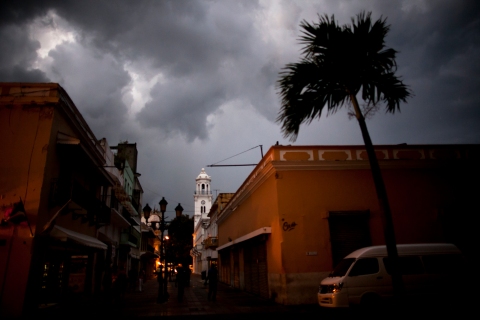
Santo Domingo: Calle Conde at dusk.
2nd time around…
March 25, 2012
This is the second attempt at blogging. I hope it’s a lot more successful than the first!
So, several weeks ago I (again) met up with a young Austrian Anthropologist I first met several years previous whilst living in Thailand. I’d been planning a trip to Argentina, indeed planning a project for the last 12 months to mark the 30th anniversary of the Falklands War. One that would have taken me across the UK, Argentina and to the Falklands, between 2nd April and 14th June this year. Then I got distracted. (easily done)
A weekend in London, disillusionment with commissioning editors and the opportunity to travel to Dominican Republic to shoot a feature on Voodoo has brought me to Santo Domingo.
I’m lucky to work with a talented and professional Anthropologist named Clarissa. A PhD student at Manchester, not only does she have good contacts and incredible access but is also fluent in Spanish – just as well really as the little Spanish I know barely gets me past the pleasantries.
So, what I hope will follow in the coming days, weeks months is a series of posts / images documenting my experiences here in Rep Dom and onwards. Feel free to ask questions, comment on images/posts etc. Hope you enjoy.
More to come soon.
